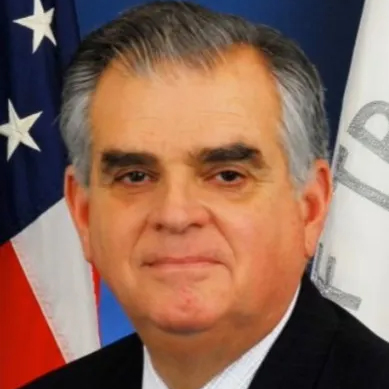Share
|
Getting your Trinity Audio player ready...
|
Intensifying climate change, worsening traffic congestion and volatile gas prices have affected us all, and it is now clearer than ever that our nation deserves a world-class high-speed rail network powered by carbon-free energy. In order to compete globally, decarbonize the transportation sector and achieve long-term energy security, we urgently need to get serious about high-speed rail.

Ray LaHood
Opinion
Special to CalMatters
During my tenure as secretary of transportation, one of President Obama’s visions was development of a high-speed rail program and we included $8 billion for high-speed rail initiatives in the economic stimulus bill. The Obama administration was especially proud to help launch the rail program in California, advanced under the visionary leadership of former Gov. Jerry Brown, with a $4 billion investment.
Opponents of California’s high-speed rail program continue to jeer from the sidelines, as the project reports new cost increases. But the real impediment to progress is a long-term lack of federal support for high-speed rail.
In recent decades, America invested trillions to maintain and expand highways and air travel, while European and Asian nations invested heavily in high-speed trains. Between 1949 and 2017, the federal government invested only $10 billion in high-speed rail with $4 billion of that dedicated to the California project, compared to investments of $777 billion in aviation and over $2 trillion in highways.
Meanwhile, since 2004, China has invested over $1.4 trillion to build a 25,000-mile high-speed rail network, and is pouring billions more into high-speed rail projects worldwide.
Fortunately, the Bipartisan Infrastructure Law, which includes $66 billion in funds for passenger rail, is the best opportunity yet to begin to catch up with the rest of the world. More than a decade after the Obama administration made that initial investment in California and the Northeast Corridor, it’s time for the federal government to step up and provide much more funding — resources needed to bring two or three high-speed rail lines into service that can demonstrate this transformative technology to the American people.
Though new federal funding for high-speed rail has been unavailable for over a decade, high-speed rail projects have advanced steadily in spite of the difficult circumstances. Private companies, namely Texas Central and Brightline, have stepped into the breach to take the lead on the development of bullet trains in Texas and the Southwest. Meanwhile, the state of California has shouldered 85% of its project’s costs, compared to only 15% covered by the federal government. Compare that to Interstate Highway Projects, where the federal government covers 90% and has done so in every state across America for decades.
A funding infusion of $8 billion would help California complete a 171-mile operating line in the state’s Central Valley while spreading the burden a bit more — 65% for California and 35% for the federal government. Another $3.75 billion would allow Brightline to raise enough private capital to complete a $10 billion, 218-mile high-speed line linking Las Vegas and Southern California.
For President Biden, a lifelong proponent – and user – of passenger rail, investing robustly in California High-Speed Rail and the Brightline West project would constitute an important part of his legacy. These two projects will eventually link up, carrying tens of millions of passengers every year and revolutionizing mobility between Nevada, Southern California and Northern California.
In addition to being remembered for modernizing the Northeast Corridor, the President could be remembered for laying the foundations of a West Coast super-megaregion connected by state-of-the-art high-speed rail. Fully funding these key high-speed rail projects and modernizing the Northeast Corridor is how we ignite our nation’s second great rail revolution – a goal laid out by Biden on the campaign trail.
As we’ve learned over the years, the federal government can’t expect transformative results with piecemeal funding for major infrastructure projects like high-speed rail. To launch America’s 21st century rail revolution, we must go big.
About the Author
Ray LaHood, a Republican from Illinois, was the U.S. secretary of transportation from 2009-2013. He represented the 18th Congressional District in Illinois from 1995-2009. CalMatters is a nonprofit, nonpartisan newsroom committed to explaining California policy and politics.
Make Your Voice Heard
GV Wire encourages vigorous debate from people and organizations on local, state, and national issues. Submit your op-ed to rreed@gvwire.com for consideration.
RELATED TOPICS:
Categories

7-Eleven Inc Says CEO Jeo DePinto to Retire


















